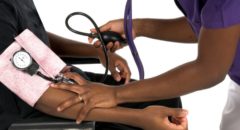 Believe it or not, having a stroke, also called cerebrovascular accident (CVA), is preventable. In fact, 9 out of 10 strokes are preventable, according to a new study. Researchers discovered that 10 controllable risk factors account for 90 percent of all strokes worldwide. The #1 preventable risk factor? High blood pressure (hypertension), a condition affecting 1 in 3 African Americans.
Believe it or not, having a stroke, also called cerebrovascular accident (CVA), is preventable. In fact, 9 out of 10 strokes are preventable, according to a new study. Researchers discovered that 10 controllable risk factors account for 90 percent of all strokes worldwide. The #1 preventable risk factor? High blood pressure (hypertension), a condition affecting 1 in 3 African Americans.
The study, published July 15 in The Lancet, involved nearly 27,000 people from every continent and confirmed that HBP, which damages arteries so they burst or clog more easily, is the most important modifiable risk factor in all regions.
READ: Why Are Blacks More Likely To Die From Stroke?
"This study is of an adequate size and scope to explore stroke risk factors in all major regions of the world, within key populations and within stroke subtypes," said study co-leader Dr. Martin O'Donnell, an associate clinical professor in the Population Health Research Institute at McMaster University in Hamilton, Canada, and the HRB-Clinical Research Facility in Galway, Ireland, in The Lancet.
African Americans, according to the National Stroke Association, are more impacted by stroke than any other racial group. In fact, strokes happen earlier in African Americans and we are twice as likely to die from stroke than Caucasians.
Researchers ranked specific risk factors to determine the impact each had on the risk for stroke. Unsurprisingly, eradicating high blood pressure was estimated to reduce stroke risk by nearly 48 percent.
Other measured risk factors included:
- Physical inactivity: 36 percent
- Poor diet: 23 percent
- Obesity: 19 percent
- Smoking: 12 percent
- Heart causes: 9 percent
- Lipids (blood fats): 27 percent
- Diabetes: 4 percent
- Alcohol use: 6 percent
- Stress: 6 percent
According to study co-leader Dr. Salim Yusuf, professor of medicine and executive director of the Population Health Research Institute at McMaster University, "Our findings will inform the development of global population-level interventions to reduce stroke, and how such programs may be tailored to individual regions, as we did observe some regional differences in the importance of some risk factors by region."
So how does one control their blood pressure in order to prevent myocardial infarction and stroke?
- Eating a better diet – this includes cutting back on sodium (salt)
- Manage daily stressors
- Maintain a healthy weight
- Limit excessive drinking
- Exercise regularly
- Limit the amount of alcohol you drink
- Cut back on caffeine
- Quit smoking
- Keep a close eye on your HBP
By adopting a heart-healthy lifestyle, you can:
- Reduce high blood pressure
- Prevent or delay the development of HBP
- Enhance the effectiveness of blood pressure medications
- Lower your risk of heart attack, heart disease, stroke and kidney disease
For more information on stroke warning signs and prevention, click here.









